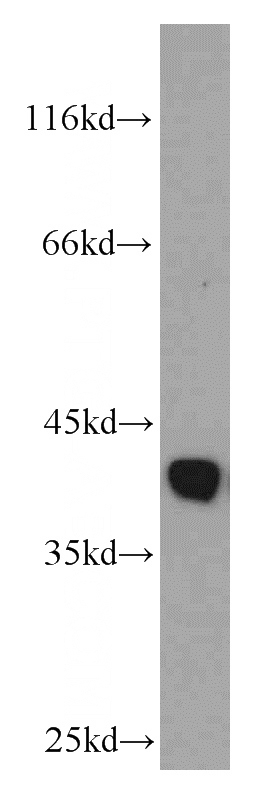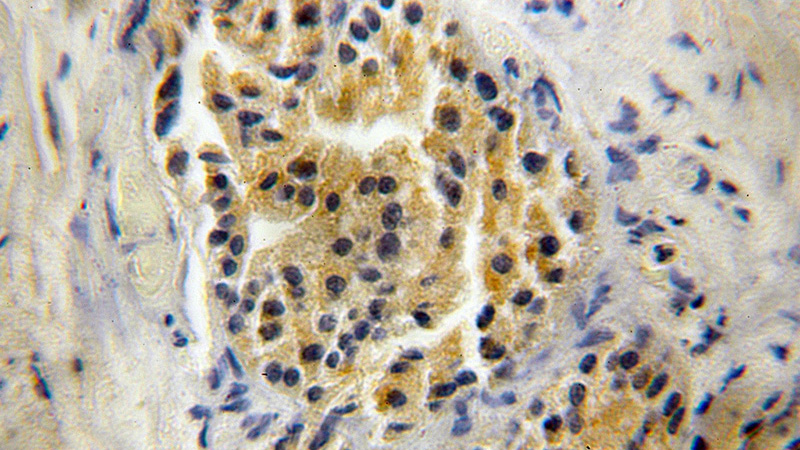-
Product Name
GSNOR,ADH5 antibody
- Documents
-
Description
GSNOR,ADH5 Rabbit Polyclonal antibody. Positive WB detected in mouse kidney tissue, human brain tissue, human heart tissue, human liver tissue, mouse brain tissue. Positive IHC detected in human prostate cancer. Observed molecular weight by Western-blot: 40kd
-
Tested applications
ELISA, WB, IHC
-
Species reactivity
human, mouse, rat; other species not tested.
-
Alternative names
ADH5 antibody; ADH 3 antibody; GSH FDH antibody; Alcohol dehydrogenase class 3 antibody; FDH antibody
-
Isotype
Rabbit IgG
-
Preparation
This antibody was obtained by immunization of GSNOR,ADH5 recombinant protein (Accession Number: NM_000671). Purification method: Antigen affinity purified.
-
Clonality
Polyclonal
-
Formulation
PBS with 0.1% sodium azide and 50% glycerol pH 7.3.
-
Storage instructions
Store at -20℃. DO NOT ALIQUOT
-
Applications
Recommended Dilution:
WB: 1:200-1:2000
IHC: 1:20-1:200
-
Validations

mouse kidney tissue were subjected to SDS PAGE followed by western blot with Catalog No:111174(GSNOR,ADH5 antibody) at dilution of 1:800

Immunohistochemical of paraffin-embedded human prostate cancer using Catalog No:111174(GSNOR,ADH5 antibody) at dilution of 1:50 (under 40x lens)
-
Background
ADH5, also named as ADHX, FDH FALDH GSH-FDH ADH3 and GSNOR, belongs to the zinc-containing alcohol dehydrogenase family and Class-III subfamily. It is remarkably ineffective in oxidizing ethanol, but it readily catalyzes the oxidation of long-chain primary alcohols and the oxidation of S-(hydroxymethyl) glutathione. ADH5 mediates multiple cardiovascular functions. It plays in regulating heterocellular communication in the artery wall. (PMID:21071693)
-
References
- Wu X, Du L, Xu X, Tan L, Li R. Increased nitrosoglutathione reductase activity in hypoxic pulmonary hypertension in mice. Journal of pharmacological sciences. 113(1):32-40. 2010.
- Straub AC, Billaud M, Johnstone SR. Compartmentalized connexin 43 s-nitrosylation/denitrosylation regulates heterocellular communication in the vessel wall. Arteriosclerosis, thrombosis, and vascular biology. 31(2):399-407. 2011.
- Marozkina NV, Wei C, Yemen S. S-nitrosoglutathione reductase in human lung cancer. American journal of respiratory cell and molecular biology. 46(1):63-70. 2012.
- Chakravarti R, Stuehr DJ. Thioredoxin-1 regulates cellular heme insertion by controlling S-nitrosation of glyceraldehyde-3-phosphate dehydrogenase. The Journal of biological chemistry. 287(20):16179-86. 2012.
- Karim S, Liaskou E, Hadley S. An in vitro model of human acute ethanol exposure that incorporates CXCR3- and CXCR4-dependent recruitment of immune cells. Toxicological sciences : an official journal of the Society of Toxicology. 132(1):131-41. 2013.
- Sips PY, Irie T, Zou L. Reduction of cardiomyocyte S-nitrosylation by S-nitrosoglutathione reductase protects against sepsis-induced myocardial depression. American journal of physiology. Heart and circulatory physiology. 304(8):H1134-46. 2013.
- Chen Q, Sievers RE, Varga M. Pharmacological inhibition of S-nitrosoglutathione reductase improves endothelial vasodilatory function in rats in vivo. Journal of applied physiology (Bethesda, Md. : 1985). 114(6):752-60. 2013.
- Hu T, Beattie WS, Mazer CD. Treatment with a highly selective β₁ antagonist causes dose-dependent impairment of cerebral perfusion after hemodilution in rats. Anesthesia and analgesia. 116(3):649-62. 2013.
Related Products / Services
Please note: All products are "FOR RESEARCH USE ONLY AND ARE NOT INTENDED FOR DIAGNOSTIC OR THERAPEUTIC USE"
